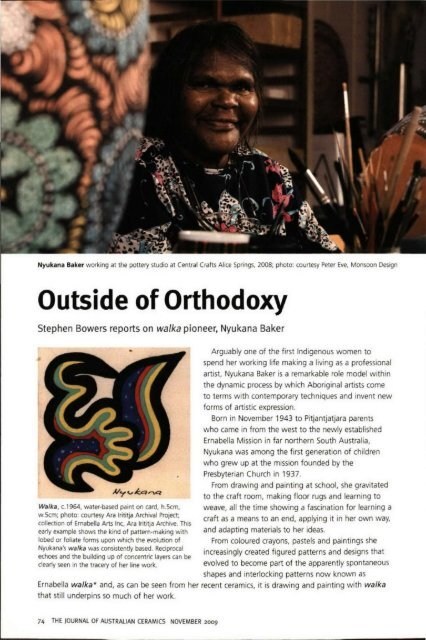The Journal of Australian Ceramics Vol 48 No 3 November 2009
Create successful ePaper yourself
Turn your PDF publications into a flip-book with our unique Google optimized e-Paper software.
Nyukana Baker working at the pottery studio at Central Crafts Alice Springs, 2008; photo: courtesy Peter Eve, Monsoon Design<br />
Outside <strong>of</strong> Orthodoxy<br />
Stephen Bowers reports on walka pioneer. Nyukana Baker<br />
Arguably one <strong>of</strong> the first Indigenous women to<br />
spend her working life making a living as a pr<strong>of</strong>essional<br />
artist, Nyukana Baker is a remarkable role model within<br />
the dynamic process by which Aboriginal artists come<br />
to terms with contemporary techniques and invent new<br />
forms <strong>of</strong> artistic expression.<br />
Born in <strong>No</strong>vember 1943 to Pitjantjatjara parents<br />
who came in from the west to the newly established<br />
Ernabella Mission in far northern South Australia,<br />
Nyukana was among the first generation <strong>of</strong> children<br />
who grew up at the mission founded by the<br />
Presbyterian Church in 1937.<br />
From drawing and painting at school, she gravitated<br />
to the craft room, making floor rugs and learning to<br />
Walka , c.1964, water-based paint on card, h.5cm, weave, all the time showing a fascination for learning a<br />
w.5cm; photo: courtesy Ara Irititja Archival Project;<br />
craft as a means to an end, applying it in her own way,<br />
collection <strong>of</strong> Ernabella Arts Inc, Ara Irititja Archive. This<br />
early example shows the kind <strong>of</strong> pattern-making with and adapting materials to her ideas.<br />
lobed or foliate forms upon which the evolution <strong>of</strong> From coloured crayons, pastels and paintings she<br />
Nyukana's walka was consistently based. Reciprocal<br />
increasingly created figured patterns and designs that<br />
echoes and the building up <strong>of</strong> concentric layers can be<br />
clearly seen in the tracery <strong>of</strong> her line work.<br />
evolved to become part <strong>of</strong> the apparently spontaneous<br />
shapes and interlocking patterns now known as<br />
Ernabella walka* and, as can be seen from her recent ceramics, it is drawing and painting with walka<br />
that still underpins so much <strong>of</strong> her work.<br />
74 THE JOURNAL OF AUSTRALIAN CERAMICS NOVEMBER <strong>2009</strong>


















